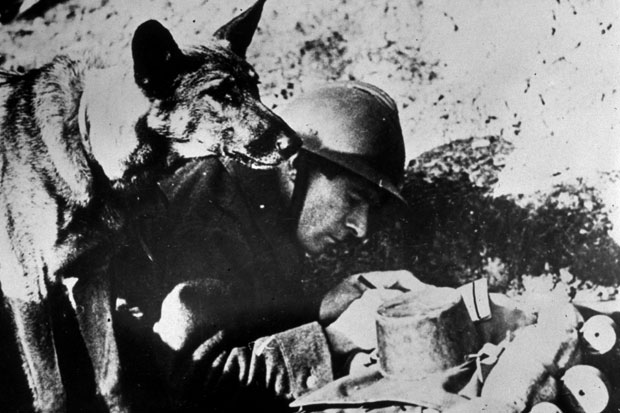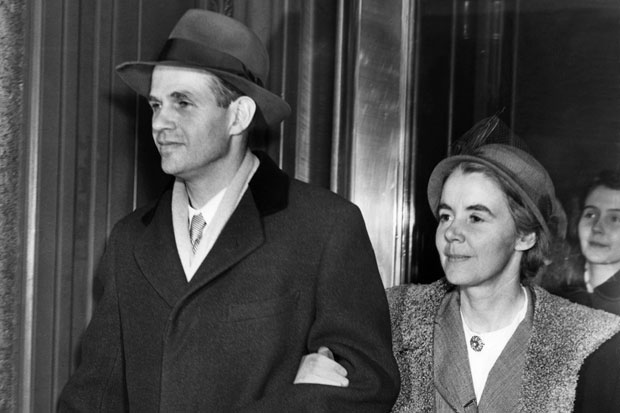If you love dogs and or live with one — I declare an interest on both counts — there is enough here about what the authors too often call ‘doggies’ to keep you interested. But what I liked about this book, despite its trickle of cute language, is that the title exactly tells the story. The dogs indeed went to war, and they were trained to do unpleasant things, including committing suicide by charging into German strongholds carrying bombs, seeking out and identifying landmines, finding bodies under rubble, and guarding bases. But according to Clare and Christy Campbell, war dogs’ effectiveness, despite much heroic, sometimes false, publicity, is doubtful. Another lie, intended to enrage British dog-lovers, was that in Germany ‘three million dogs were compulsorily destroyed.’
Doubts exist right down to whether a dog’s famous sense of smell was useful in detecting either landmines or enemy soldiers; experiments by a physiologist on this ability, including severing their scent organs, seemed to show that with or without their smellers intact, dogs were equally good, or not so good, at detection. Mine-hunting dogs, the scientist contended, ‘were next to useless…their wartime “success” had been an illusion.’ I wish the authors, who have already published the story of Bonzo, a genuine hero dog, had taken a chance and declared whether they thought most war dogs were genuinely useful, if not heroes.
Never mind. There is plenty of fascinating information here. For example, before a wartime role was found for dogs, with food running short in Britain and rationing well established, tens of thousands of them were put down. After much havering and argument inside various war offices, a few dogs, and then gradually many, were given a possible military role. For the most part they were not conscripted. Owners were invited to offer them to the army, instead of to the dog-killers; very slowly this happened, which gives the authors the chance to add a few tear-bringing accounts (I’m not being sarcastic) of children and wives remembering how it felt to give up Rex. (Dogs seem not be called Rex any more, nor do I meet Adolfs, a common name for captured German dogs that were easily turned against their Nazi handlers.)
It will, I hope, astonish some of today’s dog trainers to read that the secret of British dog-training in the second world war was not disciplining dogs to know who was the (mythical) to-be-feared wolf-pack master, but employing love, kindness and encouragement — easy enough for those soldiers from the past who were such dog-lovers that they wouldn’t shoot a German dog sniffing near their hiding places. This gentle approach contrasts with the American methods, which relied on the infliction of pain. The Japanese and the Russians also used military dogs, long before they appeared here.
Secrecy and lying surrounded the war dogs. How they died or even that they died was often disguised, unless a medal could be authorised, and a few hero dogs, it emerges, never did their deeds of derring-do. But wars require heroes.
In any event, whether mine-hunting dogs could be trusted was ignored years later by the Pentagon, which in 1998 invested $25 million on a dog’s nose programme, called — of course — Fido. After a further fortune was spent it was proclaimed that in Afghanistan ‘dogs were the best bomb detectors.’
Here again the authors are honest. The real danger to dogs after Iraq and Afghanistan — as had been the case after the second world war — was what happened to them when the war ended. It was often impossible to ‘put back the inner puppy’ entirely. Dogs trained to be aggressive have ‘behavioural issues’ which make them less likely to be good pets. This meant they were either retained in the service, or put down.
The Campbells, of course, do not compare soldier dogs with human soldiers, but several facts seem plain. Some human veterans, trained to be fierce, also are unfit for civilian life. How could that not be so? When I read in this informative book that American authorities suggested that since dogs were too eager to please, one should ‘take love’ out of their training, I think of the Marines I met in Vietnam who wore necklaces made of the ears of dead enemy soldiers.
Got something to add? Join the discussion and comment below.
Get 10 issues for just $10
Subscribe to The Spectator Australia today for the next 10 magazine issues, plus full online access, for just $10.
Available from the Spectator Bookshop, £12.99 Tel: 08430 600033. Jonathan Mirsky is a historian of China and a former East Asia editor of the Times.
You might disagree with half of it, but you’ll enjoy reading all of it. Try your first month for free, then just $2 a week for the remainder of your first year.














Comments
Don't miss out
Join the conversation with other Spectator Australia readers. Subscribe to leave a comment.
SUBSCRIBEAlready a subscriber? Log in